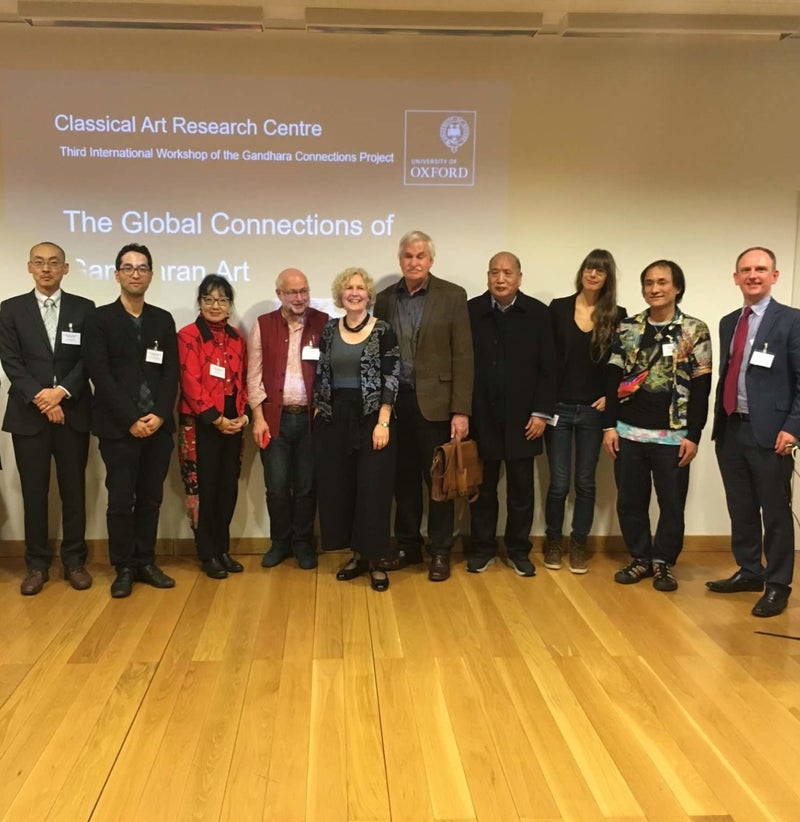While the idea of archaeologists travelling the world, exploring ruins and remote places, appeals to the imagination (and is, in many cases, also true) – we also spend a lot of time writing scientific publications and giving speeches about our findings at all kinds of academic conferences. In this blog we will share some of our experiences from such conferences: the Gandhara Connections symposium in Oxford in the spring of 2019, and the international conference ‘Alexandria the Cosmopolis’ in Alexandria, Egypt, in the winter of 2019.


At the late antique agora in Alexandria Speakers at the Oxford conference 2019
Especially when you have new findings or different approaches to present, gatherings like these can make even the most seasoned scientist a bit nervous. Academics do not shy away from giving (very) critical feedback or asking difficult questions. Of course, most of the time, such debates add to a better understanding of the materials – that is the reason why these conferences are organized to begin with. They are a chance for scientists from all over the world to gather in one place and discuss the similar topics that they have been working on. In this way, new connections can be made, and sometimes entirely new projects and collaborations are the result. Conferences are not always so fruitful, unfortunately: sometimes, they are simply very long days of listening to presentations that have little to do with your own research.
To prevent that from happening, symposia like two organized in Oxford and Alexandria, make sure to invite scholars who all work in similar fields. In the case of Oxford: Buddhist art with connections to the ancient Gandhara region in modern-day North India and Pakistan. And in Alexandria: gathering all kinds of historical evidences of the connections between the ancient city of Alexandria and the wider world.
In Oxford, our project leader Marike focused her speech on the work conducted by our team on the Buddhist rock art from the Karakorum mountains in Pakistan (see also Alex’ blog about this fieldwork). The entire symposium was live-streamed worldwide and the videos are available online to watch. (For those interested, you can watch Marike’s speech via the links section of this site).


One of the medieval Oxford colleges At the famous Eagle & Child pub
In Alexandria, the emphasis was more on networking with other scholars to exchange results and ideas of our work in progress, especially concerning the Egyptian ports, from and to where many ancient merchants sailed the Red Sea and the Indian Ocean. As a result, our team made important connections with Egyptian archaeologists working in the Delta and at port sites, as well as Silk Road scholars interested in Indian Ocean trade exchanges between Africa and the East. For future research collaborations such contacts are very valuable – especially for scientists who are at the start of their careers, working together like this and exchanging ideas is very useful and encouraging.
Conferences do not end when all the presentations are done. The speakers are often invited to dinners, during which even more ideas are exchanged and networking is done. And there are also opportunities to visit historical and archaeological sites. Oxford is famous as one of the world’s oldest universities (founded in ca. 1096 CE), with castle-like medieval colleges, museums and the Bodleian Library. Several students accompanied our team to get first-hand experience of what a professional academic conference is like – and of course they all took the opportunity to explore the historical town of Oxford, too.


At the (sunken) Pharos lighthouse in Alexandria Visiting the pyramids in Giza
In Egypt, the main team members came along, with our PhDs Rishika and Sam also attending the conference to network with other scholars. And afterwards we returned to Cairo where, of course, we did our fair share of sight-seeing at the Egyptian Museum and the pyramids and sphinx in Giza, where we were welcomed by an Egyptian colleague who very kindly showed us around the sites and shared inside-knowledge. Not every conference comes with the opportunity to crawl through the narrow granite corridors of a great pyramid, but it is chances like this, to get close to the materials you study, that make them attractive, aside from the important impact they can have in terms of research.
In reality, academic conferences can be long and often tiring days of intense discussions; you need a few days to recover afterwards. But especially for an up-and-coming project like ours, they are very important – and worth the efforts of trying to arrange all the funding and travel costs. And luckily, when travelling together with our team, we also have a lot of fun along the way.


Add comment
Comments